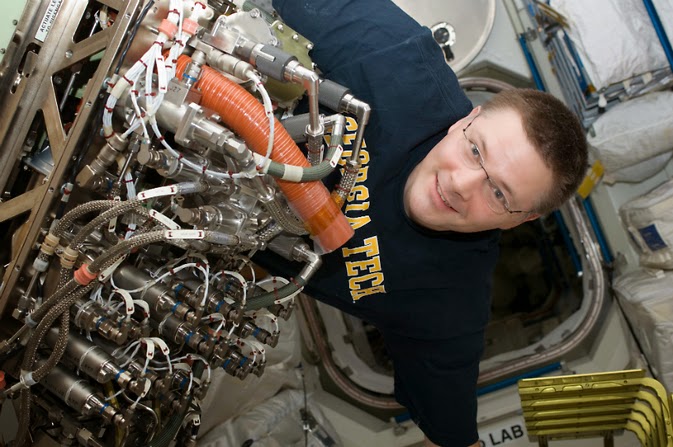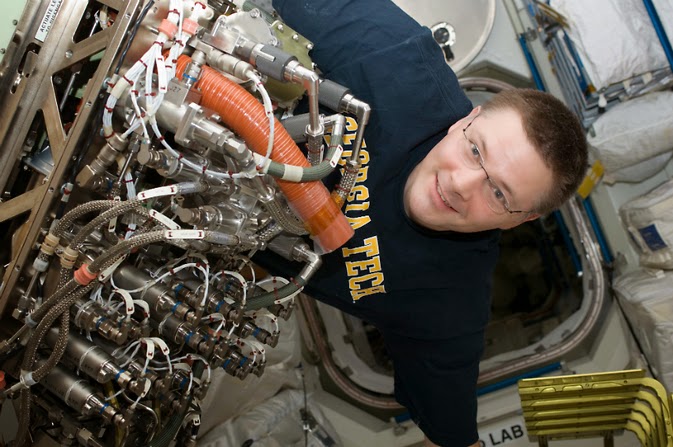NASA has selected four partners to develop game changing technologies with the potential to increase the oxygen recovery rate aboard human spacecraft to at least 75 percent while achieving high reliability. These oxygen recovery and recycling technologies will drive exploration and enable our human journey to Mars and beyond.
“Improving oxygen recovery while achieving high reliability is critical for any long-duration human spaceflight missions where oxygen resupply from Earth isn’t available,” said NASA Associate Administrator for Space Technology Michael Gazarik. “NASA recognizes that sustained technology investments must be made to mature the capabilities required to reach the challenging destinations that await exploration; such as cis-lunar space, an asteroid, and Mars. These ambitious projects will enable the critical life support systems needed for us to venture further into space and explore the high frontier and are another example of how technology drives exploration.”
In October 2010, aboard the International Space Station, NASA astronaut and Expedition 25 commander Doug Wheelock installed the Sabatier system, which extracts more water out of the ISS atmosphere. Sabatier creates water from the byproducts of the station’s Oxygen Generation System and Carbon Dioxide Removal Assembly.
Image Credit: NASA
Phase I awards are up to $750,000, providing awardees with the funding for 15 months to complete the engineering development unit hardware phase. Technologies selected to continue to Phase II will develop prototype hardware with NASA support that provides up to $2 million per award for up to 24 months.
The organizations selected to work on the development of advanced life-support technologies are:
NASA’s Glenn Research Center, Cleveland: “Oxygen Recovery from Carbon Dioxide Using Ion Exchange Membrane Electrolysis Technology”
Glenn Research Center: “A Combined Solid Oxide Co-Electrolyzer and Carbon Formation Reactor System for Spacecraft Life Support Oxygen Regeneration”
UMPQUA Research Co., Myrtle Creek, Oregon: “Continuous Bosch Reactor”
University of Texas at Arlington: “Microfluidic Electrochemical Reactor for Oxygen Recovery via Carbon Dioxide Electrolysis”
Future maturation of these technologies may use the International Space Station National Laboratory as a proving ground to retire risk and gain experience with capabilities needed for deep-space exploration.
The gases can be vented into space and the oxygen is used for breathing. “We have developed a nanocomposite electrode that speeds oxygen evolution at lower potential. That basically means it can produce more oxygen in a shorter time with less power and less reactor volume,” said Dennis. “This is important since power on a spacecraft is limited because it comes from solar panels and spacecraft capacity also is limited. Things should be as compact and lightweight as possible.”
Current methods of oxygen recovery used on the International Space Station, or ISS, achieve only about a 50 percent recovery rate. A better recovery rate means less oxygen needs to be stored and would free up precious cargo space on prolonged missions. With current technology, a trip to Mars would take about eight months, though scientists are working to shorten that time.
Dennis said the proposed UT Arlington device has an advantage over the ISS method because not as much water is needed to achieve 75 percent recovery. The team estimates its system would require less water than what can be recovered in one day from a person’s sweat and urine. A water recovery system that converts bodily fluids to water is already at work on the ISS. For years, Dennis, Rajeshwar and Tacconi have developed novel nanocomposites to be used in targeted electrochemical reactions for fuel cells and other purposes. The new project builds on that work and is another demonstration of the key role electrochemistry can play in technological advances, Tacconi and Rajeshwar said.
SOURCES – NASA, University of Texas at Arlington

Brian Wang is a Futurist Thought Leader and a popular Science blogger with 1 million readers per month. His blog Nextbigfuture.com is ranked #1 Science News Blog. It covers many disruptive technology and trends including Space, Robotics, Artificial Intelligence, Medicine, Anti-aging Biotechnology, and Nanotechnology.
Known for identifying cutting edge technologies, he is currently a Co-Founder of a startup and fundraiser for high potential early-stage companies. He is the Head of Research for Allocations for deep technology investments and an Angel Investor at Space Angels.
A frequent speaker at corporations, he has been a TEDx speaker, a Singularity University speaker and guest at numerous interviews for radio and podcasts. He is open to public speaking and advising engagements.





[…] continue to research into this. Currently the aim is to increase the efficiency until they recycle 75% of the oxygen. But the Russian algae system in the 1970s already achieved 100% recycling of oxygen, as well as […]
[…] continue to research into this. Currently the aim is to increase the efficiency until they recycle 75{22800fc54956079738b58e74e4dcd846757aa319aad70fcf90c97a58f3119a12} of the oxygen. But the Russian algae system in the 1970s already achieved 100{22800fc54956079738b58e74e4dcd846757aa319aad70fcf90c97a58f3119a12} recycling of oxygen as well as […]”